MPLS CE Routing
In order for customers to take advantage of multiple MPLS CoS tunnels, priority or custom-queues must be configured on the MPLS customer edge (CE) device (router/switch). Figure 21-6 illustrates an MPLS access link with three Classes of Service.
Figure 21-6. MPLS IP-VPN

The CE router is configured with three queues:
High Priority (Gold)
Medium Priority (Silver)
Low Priority (Bronze)
Each queue is provisioned with a percentage of the total bandwidth; for example, Gold = 40 percent, Silver = 40 percent, and Bronze = 20 percent. The CE router assigns packets to each queue based upon configured access-lists, using a Transmission Control Protocol (TCP)/User Datagram Protocol (UDP) port, source IP host/subnet, or destination IP host/subnet.
NOTETCP/UDP port refers to the well-known port numbers that are reserved for assignment by the Internet Corporation for Assigned Names and Numbers (ICANN) for use by IP application end points, using either the TCP or the UDP. Each application type has a designated, or "well-known," port number. For example, remote job entry applications have port number 5; Hypertext Transfer Protocol (HTTP) applications have port number 80; and Post Office Protocol Version 3 (POP3) applications (e-mail) have port number 110. When one application communicates with another application at another computer on the Internet, it specifies that application in each data transmission by using the appropriate port number. |
Cisco IOS enables policing of these queues through Committed Access Rate (CAR) algorithms. CAR policies are often implemented on the CE device; however, under agreement, CAR policies can be implemented on the network service provider's PE device. CAR analyzes the packet and assigns a service class based on the packet's header information. CAR policies use access-lists to police against attributes such as source, destination, protocol, or application. CAR policies also can manage bandwidth allocation for specified traffic types; for example, ensuring that Gold classified traffic takes precedence over Silver traffic.
To enforce customer network policies, network managers configure Layer 3 thresholds based on the desired parameters, such as application or protocol. If a flow exceeds a given threshold, a variety of responses may be enacted, dropping excess packets or sending them at a lower service class (recoloring).
NOTECAR policies are used for packet classification and bandwidth management. |
EAN: 2147483647
Pages: 269